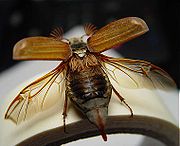
Elytron
Encyclopedia

Insect
Insects are a class of living creatures within the arthropods that have a chitinous exoskeleton, a three-part body , three pairs of jointed legs, compound eyes, and two antennae...
orders, notably beetle
Beetle
Coleoptera is an order of insects commonly called beetles. The word "coleoptera" is from the Greek , koleos, "sheath"; and , pteron, "wing", thus "sheathed wing". Coleoptera contains more species than any other order, constituting almost 25% of all known life-forms...
s (Coleoptera) and a few of the true bugs (Heteroptera
Heteroptera
Heteroptera is a group of about 40,000 species of insects in the Hemiptera. Sometimes called "true bugs", that name more commonly refers to Hemiptera as a whole, and "typical bugs" might be used as a more unequivocal alternative since among the Hemiptera the heteropterans are most consistently and...
); in most true bugs, the forewings are instead called hemelytra, as only the basal half is thickened while the apex is membranous. An elytron is sometimes also referred to as a shard.
The elytra primarily serve as protection for the hindwings underneath, which are used for flying. To fly, a beetle typically opens the elytra and then extends the hindwings, flying while still holding the elytra open, though some beetles in the families Scarabaeidae
Scarabaeidae
The family Scarabaeidae as currently defined consists of over 30,000 species of beetles worldwide. The species in this large family are often called scarabs or scarab beetles. The classification of this family is fairly unstable, with numerous competing theories, and new proposals appearing quite...
and Buprestidae can fly with the elytra closed.
In some groups, the elytra are fused together, rendering the insect flightless. Some of the ground beetle
Ground beetle
Ground beetles are a large, cosmopolitan family of beetles, Carabidae, with more than 40,000 species worldwide, approximately 2,000 of which are found in North America and 2,700 in Europe.-Description and ecology:...
s (family Carabidae) are a good example of this.
The term is also used to describe the hard scales of some polychaete
Polychaete
The Polychaeta or polychaetes are a class of annelid worms, generally marine. Each body segment has a pair of fleshy protrusions called parapodia that bear many bristles, called chaetae, which are made of chitin. Indeed, polychaetes are sometimes referred to as bristle worms. More than 10,000...
worms, notably the Polynoidae
Polynoidae
A family of scaled Polychaete worms known as the "scale worms". Short and flat, specimens reach as much as 20 cm in length and 10 cm width. An almost-constant number of small segments is the norm. They are covered by scales, technically termed elytra....
. These outgrowths of the body wall are distinguished from chaeta
Chaeta
A chaeta or cheta is a chitinous bristle or seta found on an insect, arthropod or annelid worms such as the earthworm, although the term is also frequently used to describe similar structures in other invertebrates. The plural form is chaetae or chetae.In the Polychaeta, they are located on the...
, which grow from follicles and thus possess roots.

